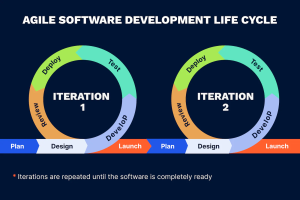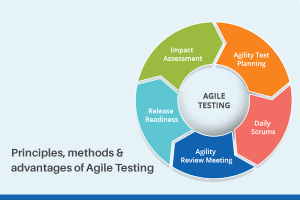In today’s fast-paced software development landscape, Agile methodologies have become increasingly popular due to their ability to deliver products faster and more efficiently. At the heart of Agile lies the concept of iterative development and continuous feedback, which necessitates a robust Quality Assurance (QA) strategy to ensure that the software meets high standards of quality while keeping up with rapid changes and iterations.
Understanding Agile QA
Agile QA is not just about testing software at the end of the development cycle. It’s about integrating quality practices throughout the entire process, collaborating closely with developers, and adapting quickly to changes in requirements. Unlike traditional waterfall methods where testing is a separate phase, Agile promotes a continuous and integrated approach to QA.

Key Strategies for Successful QA in Agile Development
1. Integration of QA into Agile Process
In Agile methodologies such as Scrum or Kanban, QA is integrated into every sprint or iteration. This means QA engineers are involved from the planning phase through to deployment and beyond. By embedding QA into the development process, teams can catch issues early and ensure that quality is maintained throughout the project lifecycle.
2. Early and Continuous Testing
One of the core principles of Agile is to test early and test often. This approach helps in identifying defects as soon as they are introduced and allows for quick remediation. Early testing also enables teams to provide immediate feedback to developers, fostering a collaborative environment focused on delivering high-quality software.
3. Test Automation
Automation plays a pivotal role in Agile QA by speeding up the testing process and ensuring consistency. Automated tests can be run frequently and across different environments, allowing teams to detect regressions early and focus manual testing efforts on more complex scenarios. Continuous Integration (CI) and Continuous Deployment (CD) pipelines further enhance the efficiency of test automation in Agile environments.
4. Collaboration and Communication
Effective communication and collaboration are fundamental to Agile QA. QA engineers work closely with developers, product owners, and other stakeholders to understand requirements, clarify user stories, and ensure that everyone is aligned on quality goals. Techniques such as pair programming, daily stand-ups, and regular retrospectives promote transparency and foster a shared responsibility for quality across the team.
5. Adaptability and Flexibility
Agile methodologies emphasize adaptability to changing requirements and priorities. QA strategies should be flexible enough to accommodate these changes without compromising on quality. Test cases and acceptance criteria should be updated iteratively based on evolving user stories and feedback from stakeholders, ensuring that the software meets current business needs.
6. Metrics and Feedback
Metrics provide valuable insights into the effectiveness of QA practices in Agile projects. Key metrics such as defect density, test coverage, and automation effectiveness help teams measure progress and identify areas for improvement. Continuous feedback loops from stakeholders and end-users further contribute to refining QA processes and enhancing overall product quality.
Quality Assurance (QA) in Agile development brings several advantages
Quality Assurance (QA) in Agile development brings several advantages that contribute to the overall success of projects. Here are the key advantages of implementing a robust QA strategy within Agile methodologies:
1. Early Detection of Issues
Agile QA emphasizes continuous testing throughout the development lifecycle. By integrating QA from the outset, teams can detect and address issues early in the process, reducing the likelihood of costly defects later on. This early detection ensures that the product remains stable and meets quality standards from the beginning.
2. Faster Time-to-Market
Agile development cycles are shorter and more iterative compared to traditional methodologies. QA processes, such as automated testing and continuous integration, help streamline development workflows. By identifying and fixing issues promptly, Agile teams can release high-quality software faster, gaining a competitive edge in the market.
3. Improved Collaboration and Communication
Agile methodologies promote close collaboration between cross-functional teams, including developers, QA engineers, product owners, and stakeholders. QA professionals work alongside developers throughout each sprint, contributing to a shared understanding of project goals and priorities. This collaboration fosters proactive problem-solving and ensures that quality considerations are integrated into every aspect of development.
4. Enhanced Product Quality
Continuous testing and frequent feedback loops in Agile QA lead to higher product quality. Automated tests ensure consistency and reliability across different software builds, while manual testing complements automation by exploring edge cases and usability issues. By maintaining rigorous QA standards, Agile teams deliver products that meet customer expectations and perform reliably in real-world scenarios.
5. Adaptability to Change
Agile methodologies are designed to accommodate changing requirements and priorities. QA processes in Agile are flexible and responsive, allowing teams to adjust test cases and acceptance criteria based on evolving user stories and feedback. This adaptability ensures that the product remains aligned with customer needs and market demands throughout the development lifecycle.
6. Continuous Improvement
Agile QA encourages a culture of continuous improvement and learning. Retrospective meetings at the end of each sprint enable teams to reflect on their processes, identify areas for enhancement, and implement corrective actions. By embracing feedback and iterating on QA practices, Agile teams optimize efficiency, minimize risks, and deliver increasingly better outcomes with each iteration.
7. Increased Stakeholder Satisfaction
By delivering high-quality software faster and more predictably, Agile QA enhances stakeholder satisfaction. Product owners and business stakeholders have visibility into project progress through regular demos and transparent communication channels. This transparency builds trust and confidence in the development team’s ability to deliver value-driven solutions that align with business objectives.

Conclusion
Implementing a successful QA strategy in Agile development requires a mindset shift towards continuous improvement, collaboration, and flexibility. By integrating QA into every stage of the development process, leveraging automation, fostering collaboration, adapting to changes, and measuring progress with metrics, teams can deliver high-quality software products that meet customer expectations and business goals.
 End to End Technology Solutions
End to End Technology Solutions
